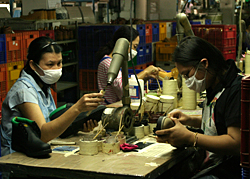

Auret van Heerden
Auret van Heerden is president and CEO of the Fair Labor Association (FLA) and has been defending human and labor rights for 35 years. His activities as a student leader in apartheid South Africa led to long periods of detention and torture by the Security Police and eventually forced him into exile in 1987. Since then he has worked for the International Labour Organization, the first democratic South African government, and, since 2001, the FLA. He is a leading proponent of the need to develop trans–national alliances to tackle global challenges that nation states cannot regulate. His ability to bring business, civil society, and public agencies together to protect rights in global supply chains is widely recognized. He serves on many boards and advisory bodies and is sought after as an inspirational speaker, but he does not let that prevent him from visiting farms and factories around the world to bring stakeholders together to respect rights.
The way products are produced has changed dramatically in the last 30 years. Instead of vertically integrated companies that owned all the processes from raw materials to retail, we have seen a trend toward specialization and outsourcing. Specialization led to the “unbundling” of companies and a focus on core business, while outsourcing shifted the non–core functions to service providers.
This transformed some vertically organized companies into networks of suppliers and coincided with the rise of the brand—companies that focused mainly on developing and marketing a concept and contracted with suppliers to perform the lower value–added functions like assembly or light manufacturing. As globalization took off, it became possible to choose those suppliers from a growing number of countries and companies. This increased the supply of service providers and lowered their price. In addition, many of those service providers were located in countries with lower cost structures, and this further reduced the cost of manufacturing.

Buying Practices and Compliance
Following the law of supply and demand, retailers and brands spend a lot of time trying to market themselves as effectively as they can to get the best price possible. A big part of that is having the right product in the right place at the right time and as little of the wrong product at any one time. Given how unpredictable consumer behavior has become, this is a real challenge.
Some retailers and brands have tried to meet it by offering more product more often to tap into changing trends. They have replaced the traditional “seasons” with “collections,” as many as 10–12 a year. Those collections may have a lead–time of only three weeks from designer’s desk to shop shelf. Even product segments operating on more traditional cycles have shortened lead–time to one or two months. The retailers and brands are also trying to hold as little inventory as possible by placing orders at the last minute and having them delivered store–ready. This not only shifts the inventory burden to the supplier, it also shifts a lot of the financial risk, since some retailers pay the supplier only once the goods are sold and even go so far as to deduct any markdowns they may be forced to make.
The scenario that emerges, then, is of retailers and brands watching consumer trends carefully and placing orders as late as possible. They obviously want the shortest lead-times and the best price they can get. Because of intense price pressure from consumers, the retailers may cut the margins they give the brands. The brands then place the order with suppliers and in turn cut the margins and the lead–times they offer them. The suppliers then have to try to pass those price and time pressures on to someone lower down the chain. Their options are limited, however, and if the buyer also designates their sources of material inputs, the suppliers have no room to maneuver there. Given that their rent and utilities costs are not very flexible either, the adjustment variable is often workers’ wages and benefits.
There are a number of new trends in sourcing that are further complicating the life (and profitability) of suppliers. In order to probe the market, the buyer will often place a small order to test how it sells, then reorder the best–selling styles and colors with very short lead–times, sometimes as short as a week. The original small order may have gone to an Asian supplier, but the reorder will probably go to a supplier no more than a few delivery days away from the final market. This makes life especially difficult for the Asian suppliers since they have lots of small orders, with all the set–up costs involved, and fewer large orders on which they can achieve economies of scale.
All of this is to be expected in a competitive market. Every player wants to buy low and sell high and time it just right. Theoretically, the players are all willing buyers and willing sellers exchanging goods at market prices. Unfortunately, the operation of many markets, especially global ones, is not perfect, and there are inequalities in the amount of information and choice available to the different players. In fact, many of the workers crowding labor markets all over the world are so poor and vulnerable that they are obliged to accept wages and benefits below the legal minimum; at the same time, suppliers complain of order prices that are below full cost.
If everyone in the market had equal access to information and choice, things would even out, but this is not the case. The amount of information and choice declines rapidly as one moves up the supply chain from consumers to workers. The asymmetrical power that comes from this uneven distribution of information and choice leads to unequal competition and unfair outcomes.
What can we do about it? Isn’t everyone, from consumer to worker, just doing what he or she has to do to get the best deal? Well … yes and no. The price pressures are normal, and since time is money, time pressures are to be expected. The problem lies in the way people go about their business. There are best practices and there are worse practices, and then there are outright criminal practices.

If supply–chain actors do not analyze and benchmark their practices, they may find that they are engaging in bad practices and their impact on the other actors in the supply chain is negative. Buyers, for example, have so much more information and choice that they can play suppliers off against one another to get incredibly low prices. The supplier may not have enough information to cost and schedule the work realistically. In bidding wars for orders, the suppliers may not even have the time to formulate a properly calculated bid.
Buyers therefore need to ask themselves whether the deals they strike are too good to be true. Are the lead–times realistic? Can the price transacted cover all the costs of production, including wages and benefits? If not, the suppliers may find themselves forced to cut corners in order to deliver on time and on budget. Some of the easiest corners to cut are labor costs and working conditions, but there are others, like sub–contracting to even cheaper suppliers. These are likely to have a negative impact on quality and labor compliance and easily lead to other problems.
At a recent meeting of the FLA Board in China, one of the participating suppliers described a best–practice sourcing relationship that his company has with a major Japanese client. The client provides an 18–month forecast so that the supplier has enough information to plan and prepare for orders. The two sides agree that the actual order levels may fluctuate by up to 20 percent without compensation, but if they exceed that margin the client is obliged to inform the supplier and to pay compensation.
The Impact of Short Term–ism
Suppliers may also complicate things. Competitive markets require continuous improvement, and that means investment in human resource development and new technology. Many labor–intensive industries, however, are reluctant to make those investments, and this limits their ability to stay competitive. Instead of upgrading to meet tighter deadlines, lower prices and more complicated styles, they look to cut costs, especially labor costs, or to move to cheaper locations. There is a clear distinction between suppliers who regard labor as a cost to be contained and those who see it as a resource to be developed. The former take the low road to competitiveness, while the latter take the high road.
Many suppliers worry about swings in order volumes and so hesitate to hire more workers when orders are up. They maintain a basic workforce adequate to meet normal order levels; when they get more orders or enter peak season, they do not hire more workers because of the transaction costs. Instead, they schedule the existing workforce to work excessively long hours. Unfortunately, the order price probably is not sufficient for the supplier to pay overtime premiums, so they end up violating wage and hour laws, running health and safety risks, and compromising quality.
This sort of supplier behavior is due to the chronic short–termism that dominates business nowadays. The short term–ism is driven by markets that have unrealistic expectations of quarterly results and force companies to stretch their supply chains to the breaking point. It is aggravated by the ease of shifting from one supplier to another and the erosion of stability, certainty, and trust between business partners. Buyers are not sure how the market will react and suppliers are never sure that they will get another order. Both seek to limit their financial exposure and to keep their options open. It will be very hard to change purchasing practices so long as the entire market is beholden to quarterly results. The environment, the workers, the community, and ultimately the businesses themselves will all suffer damage as a result.